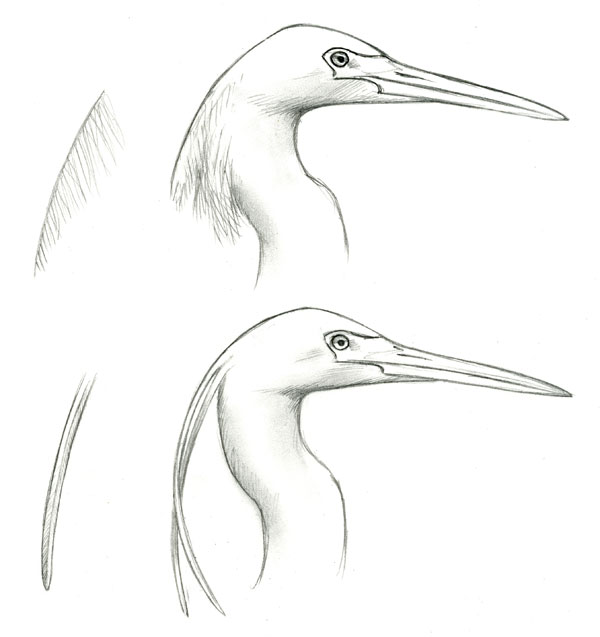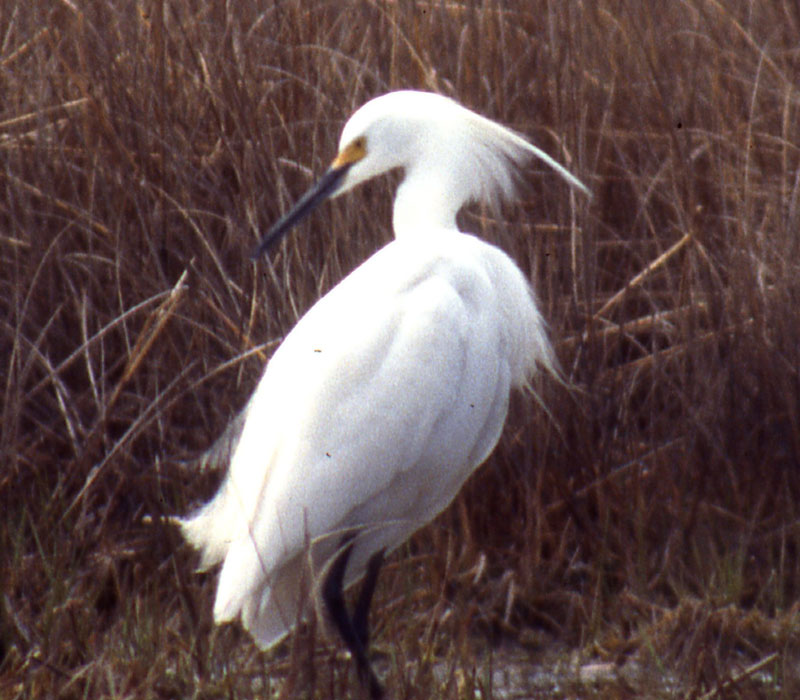In these two very similar species, the head plumes of adults provide the single most obvious and reliable distinction. The brief descriptions in field guides fail to convey the fundamental differences in these feathers, so a detailed description is given here to clarify those differences.

The head feathers of Little Egret are all “normal” except for two very long and slender plumes that grow from the back of the crown. These feathers are about 12 cm (5 inches) long, and only about 3 mm (1/8 inch) wide, but they have the structure of typical contour feathers – a central shaft with a complete vane on each side formed by many interlocking barbs. They dangle gracefully like stiff ribbons, curving in towards the neck, and flop in the breeze or as the bird moves.
The head feathers of Snowy Egret are highlighted by a cluster of many relatively short and lacy plumes growing from the rear crown and down the back of the neck. These feathers form a short bushy “crest”. Each feather is extremely flimsy and lacy, with a central shaft and long individual barbs that do not interlock with other barbs. In fact, each barb is separated from its neighbors by about one mm along the shaft. Overall the feather is triangular in outline, with the barbs growing near the base of the feather much longer than those growing near the tip.
On Snowy Egret it is generally impossible to distinguish individual feathers in this cluster so there is no confusion with Little Egret, but sometimes several feathers, or the loose barbs along one feather, can clump together along the shaft and at least suggest the longer and sturdier plumes of Little Egret. In this case these clumped feathers of Snowy Egret look messy or shaggy and do not appear smooth-sided through their whole length (they merge into the crest at their base).
Another important distinction from Little Egret is that Snowy has many modified plume feathers growing from an area that extends farther down the back of the head. In some cases (such as this bird photographed by Rick Heil at Plum Island, MA) what appears to be a single obvious plume emerges from relatively low on the back of the head, which is wrong for Little Egret,and may be just some clumped plumes of a molting Snowy.
Even more confusing… Possible hybrids?
The bird in the photo below (from Connecticut), and similar individuals photographed in New Hampshire and Antigua, seem to show mixed plumes, with the short lacy crest of Snowy Egret and two long, straight-sided plumes like Little. I’ll be publishing a more detailed discussion of these birds soon. Given the fundamental difference in plume structure seen in the two species, it’s hard to imagine a pure Snowy Egret developing such strongly Little-like plumes, so these birds may be hybrids, but that is frustratingly difficult to ascertain.



I like this posting, but even so the plumes seem so Snowy! Looking at the illustrations suddenly makes me see how Chinese has that shaggy crest effect when the bird shakes its plumes.
Pingback: Gotta Enjoy the Little Things | Studying Life
Curious about haw the egrets molt their head plumes. Do they fall off all at once or do they gradually wear away? While observing the Bombay Hook (Delaware) Little Egret Aug 2nd 2021, I observed an approximately 2 inch single plume coming off the back of the head very briefly when the wind blew or the bird moved a certain way. Could it have been a hybrid because I hesitate to count it as a lifer despite the fact it has been accepted by EBird reviewer etc.